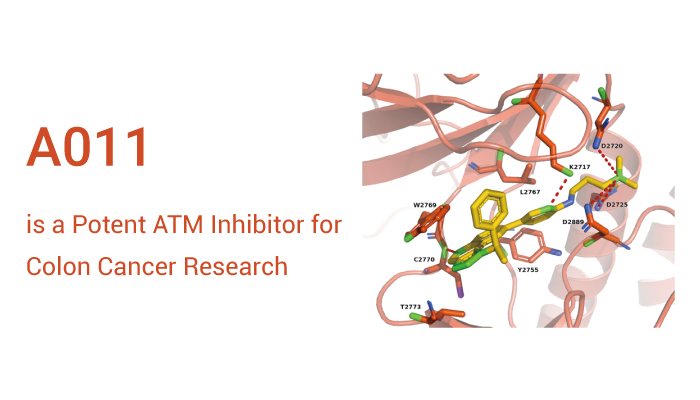ATM (ataxia-telangiectasia mutated) is a serine/threonine protein kinase that is recruited and activated by DNA double-strand breaks. Importantly, In response to DSB, the ATM kinase undergoes autophosphorylation and subsequently phosphorylates several downstream substrates, including p53, Chk2, BRCA1, RPAp34, Nbs1, and KAP1, to mediate and regulate DNA repair, cell cycle, and apoptosis. Particularly, ATM is one of the central kinases involved in DDR activation suggesting that inhibiting ATM kinase to regulate the DDR pathway may be helpful in the treatment of some cancers. Moreover, research shows that cancer cells with defective ATM functions present an enhanced sensitivity to ionizing radiation (IR). So, ATM kinase is an attractive target for cancer therapy, especially in combination with radiotherapy or chemotherapy.
In this article, we will introduce a potent ATM inhibitor, A011.

A011 is a potent and selective ataxia-telangiectasia mutated (ATM) inhibitor with an IC50 value of 1.0 nM. Besides, A011 (10, 30, 100 nM; 5 days) increases the sensitivity of SW620 and HCT116 cells to CPT-11 (HY-16562) (100 nM). Meanwhile,
A011 (0-100 nM; 24, 72 h) induces apoptosis and cell cycle arrest at the G2/M phase when combined with CPT-11. Moreover, A011 (3, 9, 27, 83, 250 nM) decreases the expression of p-ATM and p-Chk2 in a dose-dependent manner under 1.5 or 3 Gy irradiation conditions in SW620 cells. In addition, A011 (5 mg/kg; i.p.; once daily for 23 days) combines with CPT-11 (5 mg/kg, i.p.; once a week) shows antitumor activity in mice.
All in all, A011 is a potent and selective ATM inhibitor. Besides, ATM Inhibitor-7 induces apoptosis and cell cycle arrest at the G2/M phase. A011 also shows antitumor activity.
Reference:
[1] Shiyu Zhang, et al. ACS Med. Chem. Lett. 2023.